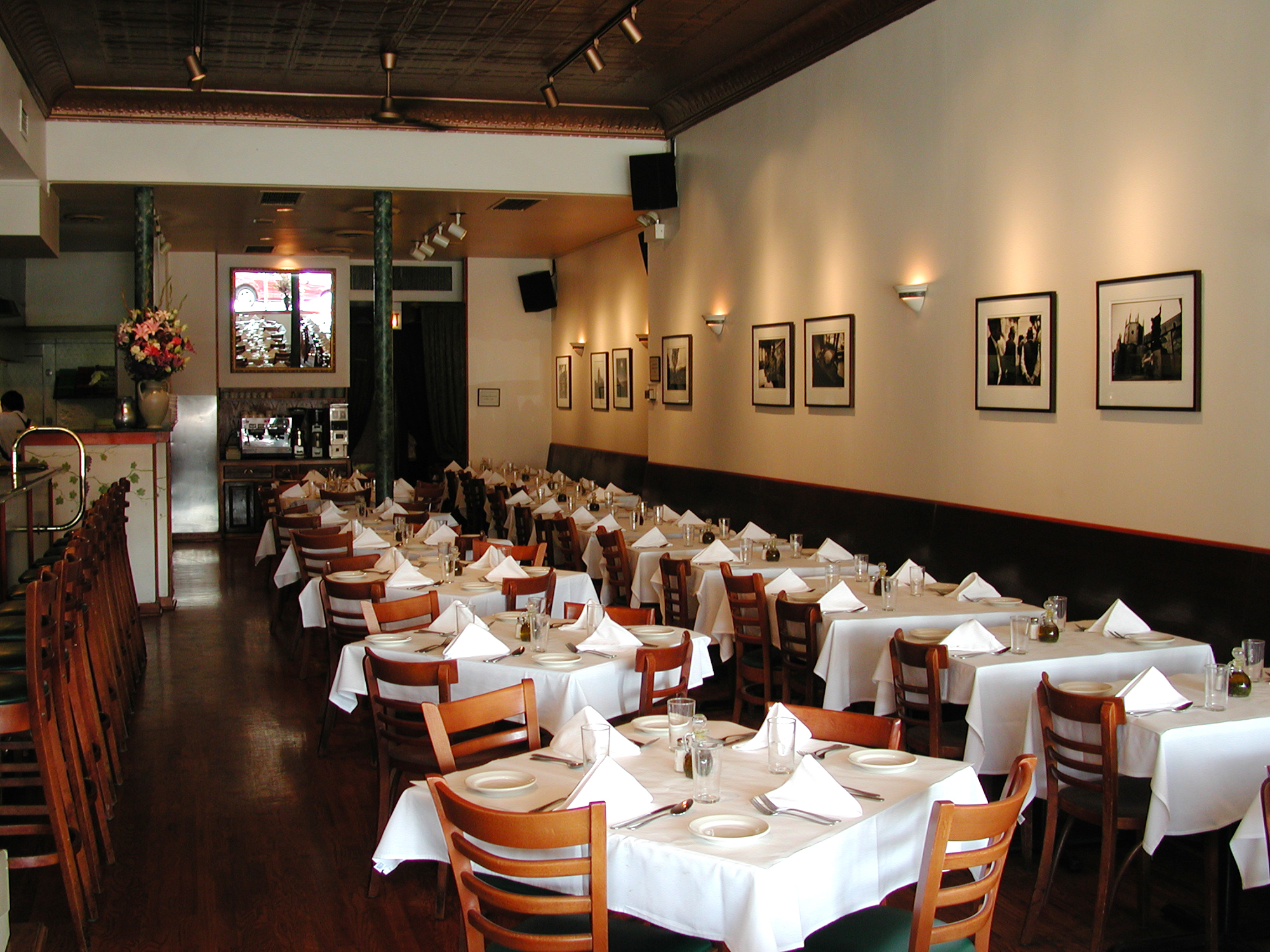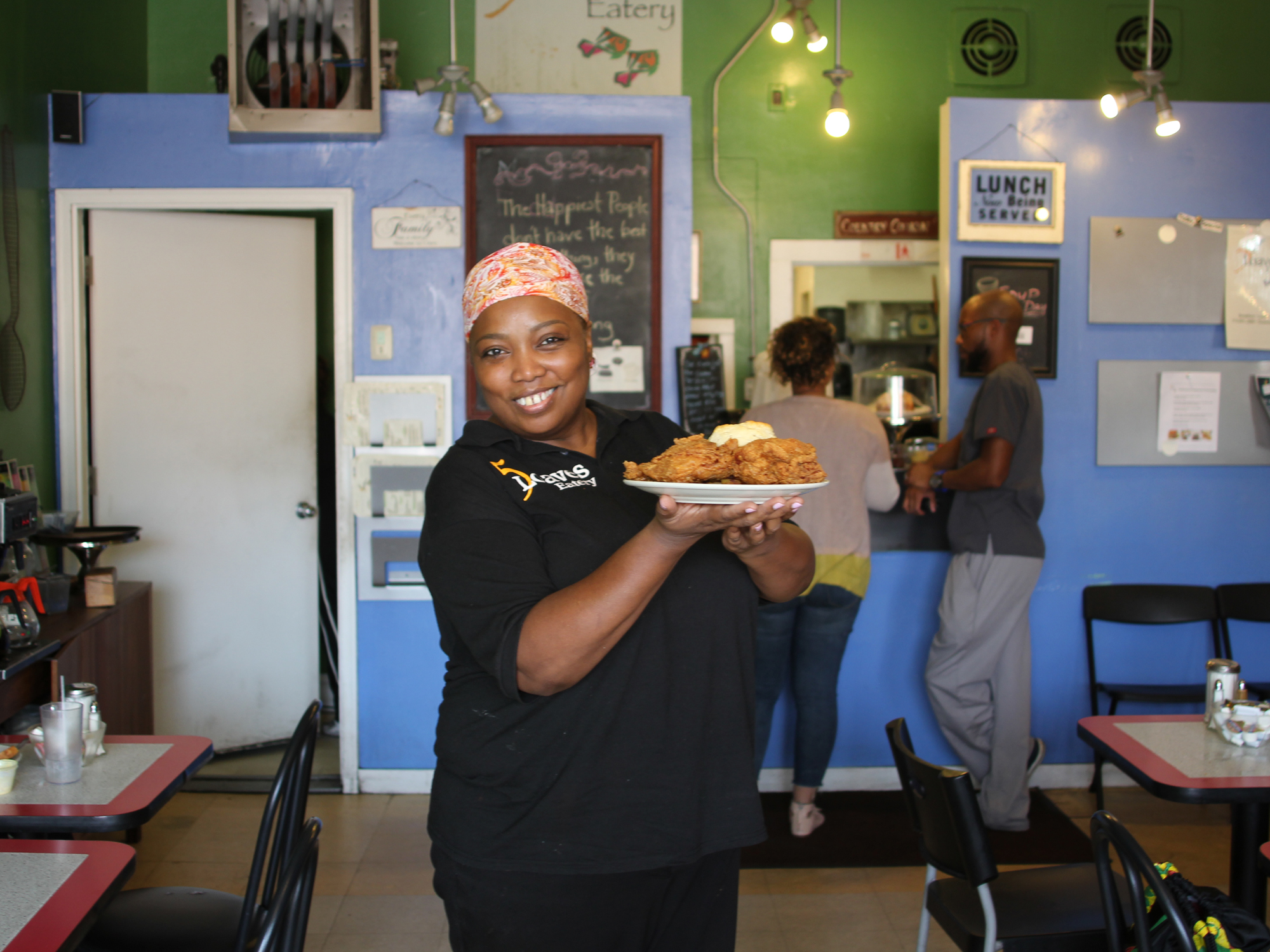CHICAGO AND THE MISSISSIPPI DELTA ARE CONNECTED—by history, by the trains that ran from New Orleans through the Delta, into Memphis and up through Illinois. This was the path of the Great Migration of African-Americans, which brought us factory workers, but also southern African-American culture—barbecue, the blues.
But it’s deceptive to see the Great Migration as an historical one-way ticket; there’s always been interplay between the two regions. That’s what The Delta, a restaurant opening later this month in Wicker Park, is out to explore. Owner Eldridge Williams, a veteran manager at Girl & the Goat, The Promontory and other restaurants, chef Adam Wendt, who worked with Williams at Bangers & Lace and other places, and beverage director Adam Kamin took trips to the region to check out the diners and shacks where things like Mississippi red hots—not hot dogs, but tamales—are made.
As Williams says, “I wanted to do a concept that had country roots. But Southern concepts got regurgitated so many times that I didn’t want to just be another Southern place. And so my research led me to the Delta, this unspoken cuisine that doesn’t get enough praise. My dad even worked for a hot tamale company when I was little, so it’s kind of funny that it really came full circle.”
So they looked to the Delta, but they also looked to the city they’re in and the Delta’s influence on it. Specifically, they looked at three Chicago specialties which grew out of the south side of Chicago in the same way dishes down south often do—by making the most out of fairly little:
• Tamales, which have made various appearances here over the last century, drawing alternately on Southern and Mexican heritage;
• The Mother-In-Law, a Depression era way of stretching a few pennies into a whole meal, serving a chili dog minus the dog by using a (cheaper) tamale in its place;
• The Jim (or Gym) Shoe, a kind of sandwich native to mostly Muslim-owned sub shops on the south side, which basically takes a little of everything in the shop and piles it on to a gloppy mess of a sandwich.
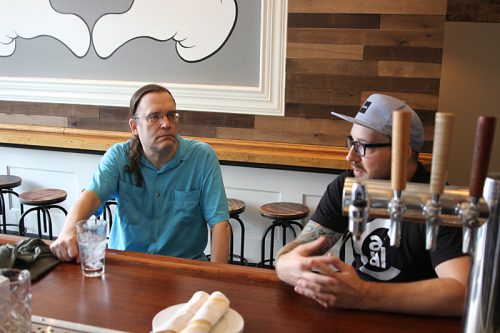
Dr. Peter Engler, and chef Adam Wendt of The Delta
The Mother-In-Law and the Jim Shoe have something else in common: Dr. Peter Engler, a biological researcher who was also one of the original participants on LTHForum, where he identified and documented both of these curious local (not just Chicago, but only certain parts of Chicago) specialties. (You can read his pieces on each here and here; you can watch him introducing Anthony Bourdain to his first Mother-In-Law here.) When Wendt mentioned the dishes to me, I asked him if he’d ever talked to Engler about them. He hadn’t, but he’d read his work extensively—and so our conversation led, a couple of weeks later, to Engler joining me at the still-under-construction restaurant to sample Wendt’s modernized takes on a couple of Sweet Home Chicago classics.
Here’s how our tasting of south side Chicago foods reconcepted for a modern Wicker Park restaurant unfolded.
Mississippi Red Hot Tamales
“The hot tamale came about because they would bring in Mexican laborers during the Civil War when the sharecroppers were off fighting,” said Wendt. “So their wives and moms and so on would basically make them a sustaining meal, which was tamales. They would throw them in a coffee can, so they could just literally throw them on a fire.”
“African-Americans saw this and basically created their own version of the tamale, using grits instead of masa, and the inside would be the cheap cuts of meat that they would get. And they simmered them, because they didn’t really have steamers, in these cauldron pots over a fire. Then in Chicago, you get the Tom Tom tamale, which is said to be based on the Delta tamale.”
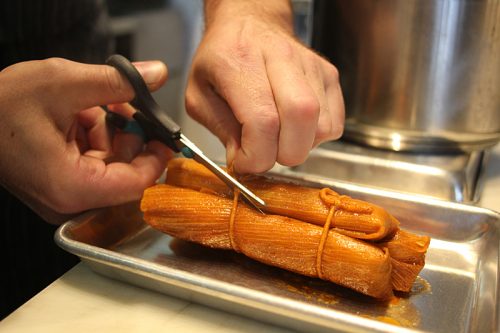
Housemade tamale at The Delta
Engler shook his head. “There are definitely similarities, but I don’t buy the whole story that a Tom Tom is just a sort of adaptation of the Delta style. Everybody quotes John T. Edge on the Tamale Trail, but the first tamales in Chicago were not via the Delta—they were sold by a Mexican street vendor before the Columbian Exposition [in 1893]. Right after the Exposition, say 1895, a group of tamale vendors from San Francisco started selling them here, and they were a huge hit.”
“In the early 20th century, tamales were just hugely popular,” Engler said. “I don’t know if it ever happened, but there was even talk about forming a tamale sellers’ union. There were all these complaints about tamale guys going around at night from bar to bar.”
“That sounds familiar,” Wendt said.
“Yeah. There’s an absolute lineage between these guys who used to walk around with lard pails, and the tamale guys now with their Igloo coolers,” Engler said.
I followed Wendt into the kitchen, where he had a couple of tamales simmering for us. “The toughest part was getting a good recipe for a Delta tamale,” he said. “The ones that are out there are wishy-washy, and you talk to anybody down there, they don’t want to give up their recipe.”

He pulled up a bundle of three tamales, wrapped in corn husks and bound by string. He cut the string and removed it, then plated them and poured more of the spicy orange liquid over them. Finally, he arranged some saltine crackers in a cast iron bowl for us—tamales are often eaten in the Delta on a cracker.
I have to admit that I don’t love the greasy cheapness of Chicago tamales—I didn’t grow up on them and thus lack pre-critical fondness for them. I vastly prefer the Mexican kind here. But Wendt’s version seemed to have averaged out the two styles, with the hearty comfiness of the Chicago style but a robust spicy profile many cuts above. Peter was impressed: “I love the level of spice. This is up there with the best of the Delta ones I’ve had.”
The Mother-In-Law
The tamale is just a building block when it comes to the next item, the Mother-In-Law. Chef Wendt had made some extra long and thin ones, to take the place of the wiener in a bun, but he had also whipped up some tamales for staff members working there—and they had torn into the long ones by accident, so he had to serve us shorter segments stretched across the bun.
Wendt explained how his version of the Depression Era classic came together. “We take one of our classic red hot tamales and deep-fry it. Then we’re throwing it on a bolillo roll—because in the Delta, there’s a lot of Mexican influence. So we do the bolillo roll that’s usually for a torta, we top it with roasted garlic oil and then with roasted poppyseeds, mimicking the Chicago-style bun. And then, instead of covering it with chili, because there’s already chili flavoring in the tamale, we decided to stack it like a Chicago dog.”
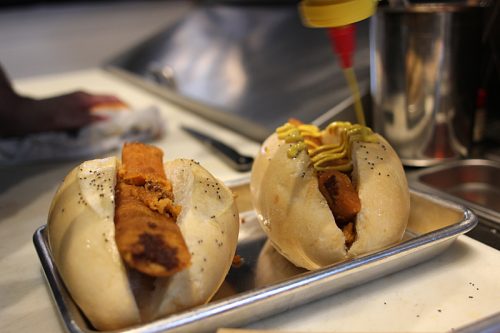
“I don’t think I’ve ever seen a mother-in-law on a poppyseed bun,” Engler said.
“No, I hadn’t either,” said Wendt. “I kind of just wanted to make it look like a Chicago dog. So it’s not really your typical Mother-In-Law. Honestly, I’m a little wary of how people will take to it. If they don’t like it and start running down the street with torches and pitchforks, we’ll throw some chili on it, get it back to the more original style.”
“Although Johnny O’s on 35th has all the hot dog toppings on theirs,” I pointed out. “Is that typical, do you think?”
“I don’t know,” Engler said. “I think sometimes, it just depends on who’s making it. They’ll put whatever you want on it. But usually it just comes with chili. Some places have both the Mother-In-Law, with just chili, and the tamale on a bun, which has all the condiments.”
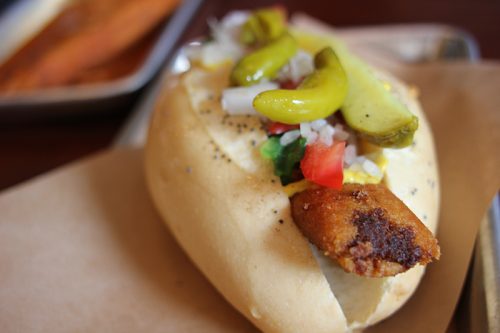
Wendt went off to the kitchen and assembled the Mother-In-Laws; on the football-shaped rolls, they looked like the Botero sculpture version of a normal stand’s Mother-In-Law on a hot dog bun, evoking an audible “Wow” from Engler as the rotund version was set in front of him. Nevertheless, it met with his approval as he bit into the giant concoction without losing the toppings stacked on it. “It’s really good,” he said. “And the roll works.”
“You think it’s too big,” Wendt said, “but it’s airy, so you can just bite into it.”
The combination of, again, the robust, spicy tamale with the hot dog toppings worked for both of us, and effectively mimicked the flavors of a chili dog with all the classic Chicago accoutrements—notably, the sport peppers, which added a vinegary crunch. Wendt said that for him, the chili flavor of the housemade tamale was enough to give it the taste of a canonical Mother-In-Law, and I agreed with that to a point—but by the end, both Engler and I agreed that even though you couldn’t call it dry, it did seem to be in need of some kind of more liquid component, just to help lubricate its journey into your insides.
“You want it dipped, like an Italian beef?” Wendt asked, half-jokingly.
“I kind of do,” I said.

That said, there was a lot to like about this modern take on an 80+ year-old Chicago sandwich. Engler said, “I’m not the biggest fan of a lot of Mother-In-Laws—they’re kind of bland, starch on starch on starch. But with the spiciness, this one is good.”
The Jim Shoe
When it came to the least-known of these Chicago inventions, Wendt was plainly excited to be able to go to the source to try to solve its mysteries. “Is there any knowledge I’m missing about the Jim Shoe? Is it named after a guy named Jim? I couldn’t find anything—I was digging for hours.”
“I’ve asked so many people, who you’d think would have thought about it,” Engler explained. “Most of these guys, who are like managers or owners—the first time I asked them was the first time they’d ever thought about it. My speculation is that it was just named after some customer named Jim. Jim probably had a special order sandwich and came in every week.”
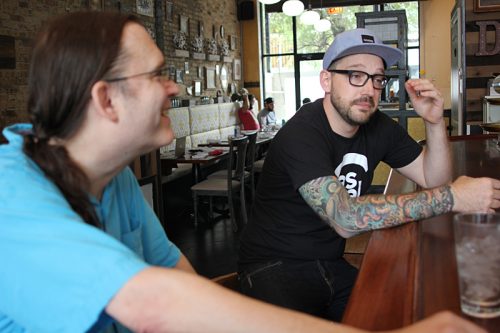
“I don’t know how far it goes back—probably to the 70s or 80s,” Engler continued. “I came across it in the 90s, and it had clearly been around for a while. I saw it on a menu, and I don’t even think it was even described. So it was known.”
Many of the places that serve it are owned by Pakistanis, and it’s made by combining everything a sandwich stand following Muslim dietary laws would have on hand. So it’s roast beef, corned beef and gyros meat, with the sauces that go with each (mayo, mustard and tzatziki), along with, usually, cheese, lettuce, tomato and onions, or some combination. But Engler doesn’t think it’s clear that it originated with Pakistani or other Muslim ownership (Palestinians in Chicago have owned business in the African-American south side going back to the early 20th century).
To me that’s the breakthrough to when the Jim Shoe became popular—throwing it on the griddle, adding the giardinera and maybe some cheese.
“I don’t know when Pakistanis started dominating the sub shop industry. In the 70s and 80s, they probably weren’t as dominant as they are now,” he explained. “Some of these were black-owned places, and they would make these combination subs. With old signboards, you’ll often see the ‘Challenge’ sub with two meats—so that’s two thirds of the way to a Jim Shoe. And the older places tend to serve it just like sliced meats, laid on.”

Mixing it all on the griddle—or frying pan, as the case may be
What the Pakistani sub shop owners may have brought to the Jim Shoe, he thinks, is the practice of slicing the meat into fine bits on the griddle, caramelizing many of the flavors in the process. “Kata kat is a Pakistani street food—they have this big round griddle and they throw, usually, organ meats and all kinds of spices on it. They take two spatulas or cleavers and just kind of chop it up on the griddle. I think the Pakistani sub shop owners adapted kata kat style cooking to the meat on a Jim Shoe.”
“When I first referred to the kata kat style to a Pakistani friend who lives in Boston, it was a joke,” Engler said. “But when I mentioned it to a couple of the owners, they immediately said yes, absolutely. To me that’s the breakthrough to when the Jim Shoe became popular—throwing it on the griddle, adding the giardinera and maybe some cheese—it makes a huge difference.”
Engler says there’s definitely an association with Muslim shop owners. “I’ve talked to a couple of older, black-owned places that don’t serve the Jim Shoe. This one guy, I asked him, do you know anything about the Jim Shoe, and he said, ‘Aw, I don’t serve that Ay-rab shit.'”
Then Engler made a confession. “I mean, honestly, I don’t even like these things that much,” he laughs. “Everybody thinks I love these things. But at least, all the ones I like the best do it on the griddle.”

Wendt agreed that chopping the meat on the griddle and getting the benefits of everything searing as it heats up are key to the Jim Shoe. His version, however, has one huge difference—no bread. “I’d had a Jim Shoe maybe a couple of times, but then it hit me—a tamale’s a perfect vessel for anything,” he said. “So I thought, I gotta do a Jim Shoe, I gotta do it right, so I’ve eaten probably 20 since then. And then it was figuring out a way that we could keep it Mississippi Delta, but still keep the integrity of the Jim Shoe.”
His answer was to take all the ingredients and serve them on an actual tamale, in place of a bun. “I mimicked kind of a loose gyro meat, with lamb, beef and pork and lots of garlic, oregano, onions,” he explained. “That goes into our house masa mix, and we simmer it in kind of a court bouillon, to make the tamale.”
“We do a house pastrami, keep it in big chunks. Then we’ll throw it on the regular flat top, with sweet peppers and Italian style roast beef. We have some provolone cheese on it, lettuce, tomatoes, and then we’re using the Vienna-style giardinera—we actually make a house giardinera, but you can’t do anything different when it’s a Jim Shoe, you know?”
The result, when Wendt had it all plated up, was far beyond the piled-up sandwiches of south side sub stands—partly because it wasn’t really a sandwich, except by a feat of imagination that calls a tamale “bread.” But especially with the housemade pastrami, which had a deep salty-smoky flavor that would elevate an actual gym shoe, this was a cross-cultural exchange on a plate, chili flavors and gyros flavors and Southern flavor from Wendt’s substitute for the customary tzatziki, Comeback Sauce, a Mississippi take on Louisiana remoulade. It’s a dish only to be eaten when you have a deep hunger, enough ambition to finish it and a long afternoon on the couch ahead of you, but it proved that the elements of the Jim Shoe had potential not achieved with the usual industrial cold cuts.
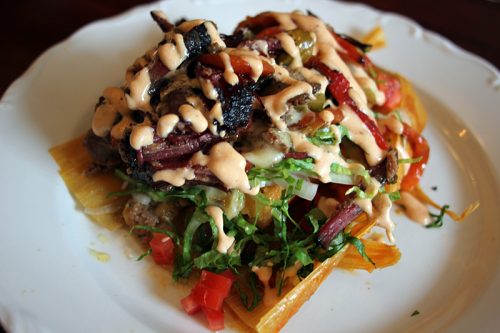
“It’s a treasure trove, man. There’s so much stuff thrown on there,” Wendt said.
“I really like the griddled part,” Engler said, as he rotated his plate to find the optimum bite. “I just got a big hunk of the pastrami,” he said, with evident satisfaction.
Wendt seemed pleased that his attempt to find the unified field theory of Delta-to-Chicago-and-back-again dishes had met with approval from the foremost scholar in the field. “I never realized until this project that there are so many people in Chicago from the Delta,” Wendt said. “They’ve just come out of the woodwork, ‘Oh, I can’t wait.’ So many people I’ve worked with, I never knew it, and they want our catfish. All those people that are from the Delta, they don’t have anywhere, yet.”
Michael Gebert is the hellhound on Chicago food’s tail as editor of Fooditor.
Latest
Join the Discussion
After you comment, click Post. If you're not already logged in you will be asked to log in or register with Disqus.






